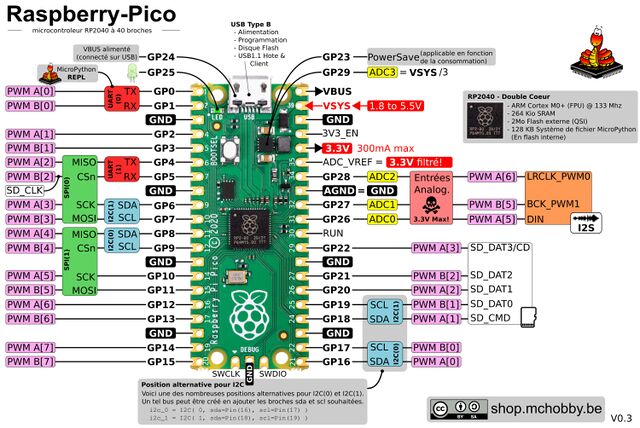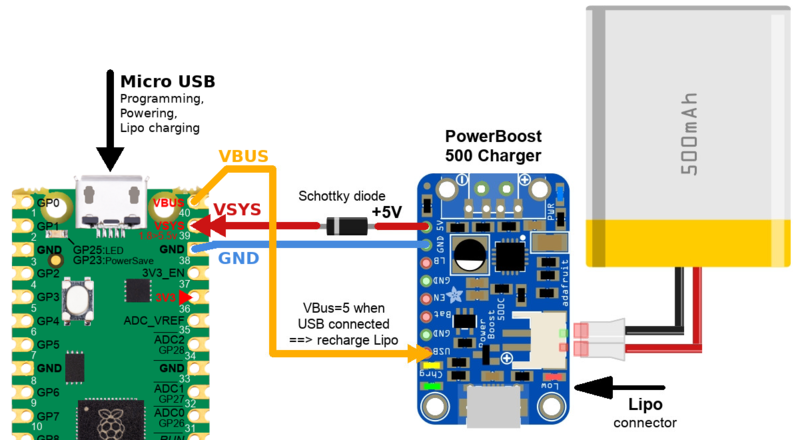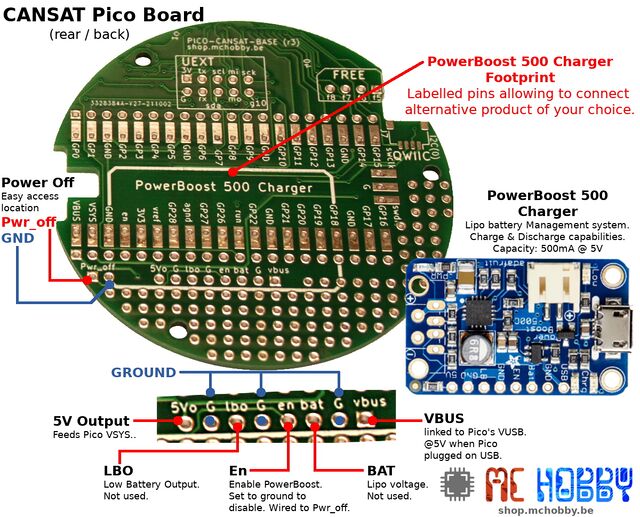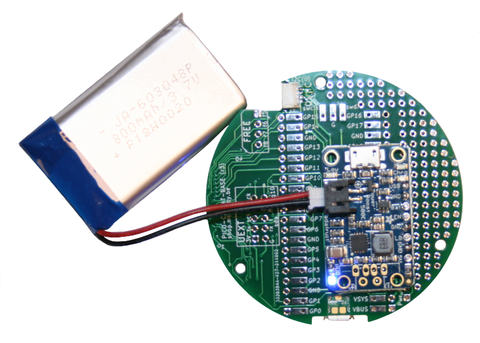ENG-CANSAT-PICO-POWERING
Abstract
|
|
En cours de traduction/élaboration. |
There are several way to power the power the Pico and your project.
The Pico run with 3.3V and can be powered with a voltage up to 5.5V. As the Pico voltage regulator is a Step-down/Step-up regulator (reduce/up-raise the source voltage) you can power it directly from batteries. Even when the battery voltage falls down under 3.3V the Pico will be able to run anyway.
Despite the simplicity to directly powering the Pico from a battery or a Lipo, there is also some interest to use specialized charging/discharging circuitery.
How to power the Pico
The Pico can be powered:
- Via the USB : so with 5V
- Via the VSYS pin : with battery having max 5.5V
- With a Battery management circuitery and smart wiring ;-) (as seen here below)
The Pico can be easily shutdown by placing the 3V3_EN pin to the ground.
This will deactivate the Pico 3.3V DC/DC regulator and spare the battery power.
Pico and PowerBoost
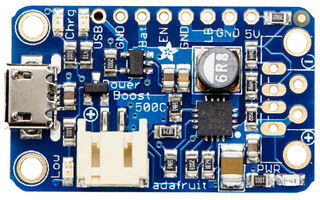
Crédit: AdaFruit Industries www.adafruit.com
The Adafruit PowerBoost 500 is a breakout board able:
- to discharge a Lipo battery to generates 5V output (500mA max)
- to charge the Lipo battery when connected to an external 5V supply
- to do the both operations at the same time.
The great thing about the PowerBoost is that microUSB connector is optional to charge the Lipo.
Just powering the breakout with 5V on the USB pin will have exactly the same effect than plug-in the USB cable.
Here how it works. Please note that only the Pico Micro USB is used in this setup.
When Pico is plugged on a computer:
For sure, you can program and interact with the board.
On the powering aspect:
- The Pico and its 3.3V regulator are powered via USB
- The Pico VBUS pin is set to 5V
- The Pico VSYS pin is also at 5V. Thanks to the diode, the 5V VSYS does not inject current into the 5V output of the PowerBoost charger.
- The 5V VBUS (on the Pico) do power the PowerBoost on the USB pin. As a result, the PowerBoost does charge up the Lipo.
Summary: the Pico is running and the Lipo is charging.
When Pico is UNPLUG from computer:
- The Pico VBUS is at 0V
- The Pico VSYS is at 0V (but this will change).
- The Pico regulator is not powered
- As the PowerBoost is running, it generates 5V on its 5V Output Pin. The 5V push the current through the diode to VSYS
- The Pico VSYS now receives 5V (a bit lower due to the diode lost). So the Pico regulator is powered and generating 3.3V.
Summary: the Pico is running and the Lipo is discharging.
How to power off:
To power-off the Pico when the USB is unplug on the Pico, we have the following options:
- Tied the Pico 3V3_EN pin to the ground : that disable the Pico but the Powerboost is still discharging and producing 5V.
- Tied the PowerBoost EN pin to the ground : this disable the PowerBoost which stops to power up the Pico. The best approach.
Pico, PowerBoost and Cansat Kit
The Kit Cansat with Pico does have a footprint to receive an Adafruit PowerBoost 500 charger. This works exactly as described above but with all the wiring already done on the board.
Just place the PowerBoost under the board. Place it over the footprint drawed and solder it with the help of a PinHeader.
Once soldered, plug a LiPo battery and the final setup should look like the following:
What are the features:
- Plug the USB on the Pico to refill the LiPo.
- Unplug the USB to make the LiPo powering the CanSat.
- The PWR_OFF connector (near the border of the board) can be fitted with a switch. Close the switch (so PWR_OFF tied to the ground) to deactivates/shutdown the PowerBoost.
- PowerBoost status LED:
|
|
En cours de traduction/élaboration. |
PowerBoost Status LEDs
The PowerBoost is filled with several LEDs indicating useful status.
- Blue LED: next to the Powerboost USB A footprint, that LED indicates the 5V output status.
- Red LED: next to the JST connector, indicates the Low battery Voltage (LiPo voltage falls under 3.2VDC).
- Yellow LED: Jaune est à côté du connecteur microUSB et indique que l'accu est en cours de charge.
- Green LED: LED Verte est également à côté du connecteur microUSB et indique que l'accu est totalement chargé.
Additional ressources
- PowerBoost 500 charger tutorial (French)
Written by Meurisse D. for MCHobby
